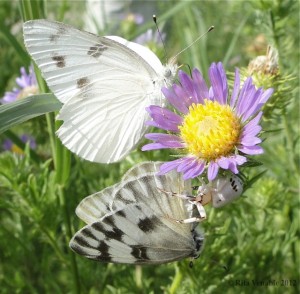Photographing butterflies is like playing golf—a good day of it, and you are ready to share stories with everyone. A bad day of it can be frustrating, but still beats being inside all day. Butterfly photography adds another dimension to butterfly observation. Sharing your photos is a good way to verify what you see in the field or garden and it inspires other people to do the same.
The time of day and weather are important in butterfly photography. Early in the morning is best for two reasons: 1, butterflies are basking and the likelihood of obtaining a full wingspan shot from above is better, and, 2, butterflies are moving slower because of lower temperature so getting them to sit still for a moment while you focus is better. Windy days usually mean blurry photos. Rainy days cause the butterflies to roost in a sheltered place, but just after a rain may be a good time to shoot if the sun comes out and the butterflies begin to nectar and bask again.
Pack your patience along with your camera. You must approach butterflies slowly or your movements will cause them to fly away. Try not to let your shadow fall on the butterfly.
Photo composition is just as important now as it ever was. For image sharpness, position your camera lens so it is parallel to the wings of the butterfly.
I use 3 cameras—a SLR with a 100 mm macro lens, a DSLR with a zoom lens, and a point and shoot. I like the 100 mm macro for very close up shots of butterfly eggs, caterpillars, chrysalises, and adults when quality is important. I carry the DSLR with the zoom lens when I am hiking and want to photograph something quickly. The point and shoot is for chance meetings with butterflies usually in urban settings. I usually always use the flash with the macro lens, but I often choose natural light with the DSLR zoom and the point and shoot. Occasionally, I make a butterfly movie, but these are not as easy to share with other people because of the size of the files.
Some people carry a phone with a built in camera. With advances in image quality, this way of photographing butterflies “on the fly” will probably improve. Recently a naturalist at an urban nature center sent me a photo of a caterpillar she had photographed with her phone. Was it magazine quality? No. Was it good enough for a quick identification and website use? You bet.
Read current camera reviews from reliable sources and talk to other photographers about their experiences with different manufacturers and models. Base your choice on what your goals are and what your budget is.
Regardless of what you choose to shoot with, let your photos reflect your field and garden experiences with butterflies. The most interesting photos tell stories. Share them with other people.
©Rita Venable 2012
